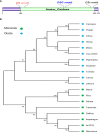CRISPR/Cas9-mediated editing of PHYTOENE DESATURASE gene in onion (Allium cepa L.)
- PMID: 37701798
- PMCID: PMC10494252
- DOI: 10.3389/fpls.2023.1226911
CRISPR/Cas9-mediated editing of PHYTOENE DESATURASE gene in onion (Allium cepa L.)
Abstract
Introduction: Clustered regularly interspaced short palindromic repeats (CRISPR)/ CRISPR-associated protein 9 (Cas9) is a precise genome editing tool used to introduce genetic modifications in a wide range of crop species. Thus far, there is no report of CRISPR/Cas9-mediated genome editing in onions (Allium cepa L.).
Methods: In the present study, we targeted two exons of the gene coding for Phytoene desaturase (AcPDS) in onion cv. Bhima Super. The sgRNA-carrying constructs were co-cultivated with 8-week-old embryogenic calli using an Agrobacterium-mediated transformation protocol and incubated on the media without hygromycin B selection.
Results and discussion: Out of the total 617 co-cultivated calli, 21 (3.4%) regenerated shoots exhibited three distinct phenotypes: albino, chimeric, and pale green; in comparison to the wild-type non-transformed regenerated shoots. Total chlorophyll content was drastically reduced in albino shoots and significantly decreased in chimeric shoots. Out of the six Cas9 gene PCR-confirmed regenerated shoots, two exhibited the albino phenotype due to insertions/deletions (InDels) and substitution-based mutations in and around the AcPDS target sites. Deep amplicon sequencing revealed a significantly variable InDel frequency between two sgRNAs, ranging from 1.2% to 63.4%, along with a 53.4% substitution frequency. The mutation of the AcPDS gene generated a visually detectable albino phenotype, thus confirming the successful editing of the AcPDS gene. This is the first time a CRISPR/Cas9-mediated genome editing protocol has been successfully established in onion, with the AcPDS gene serving as an example. This study will provide the necessary momentum for researchers to further basic and applied research on onions.
Keywords: CRISPR/Cas9; PDS; chlorophyll; genome editing; onion transformation.
Copyright © 2023 Mainkar, Manape, Satheesh and Anandhan.
Conflict of interest statement
The authors declare that the research was conducted in the absence of any commercial or financial relationships that could be construed as a potential conflict of interest.
Figures


References
-
- Bibi N., Fan K., Yuan S., Ni M., Ahmed I. M., Malik W., et al. . (2013). An efficient and highly reproducible approach for the selection of upland transgenic cotton produced by pollen tube pathway method. Aust. J. Crop Sci. 7, 1714–1722.
-
- Bisen S. P., Emerald M. (2016). Nutritional and therapeutic potential of garlic and onion (Allium sp.). Current Nutrition & Food Science 12 (3), 190–199. doi: 10.2174/1573401312666160608121954 - DOI
-
- Brewster J. L. (2008). Onions and other vegetable alliums. Onions other Veg. alliums. 15. doi: 10.1079/9781845933999.0000 - DOI
LinkOut - more resources
Full Text Sources
Other Literature Sources
Miscellaneous

